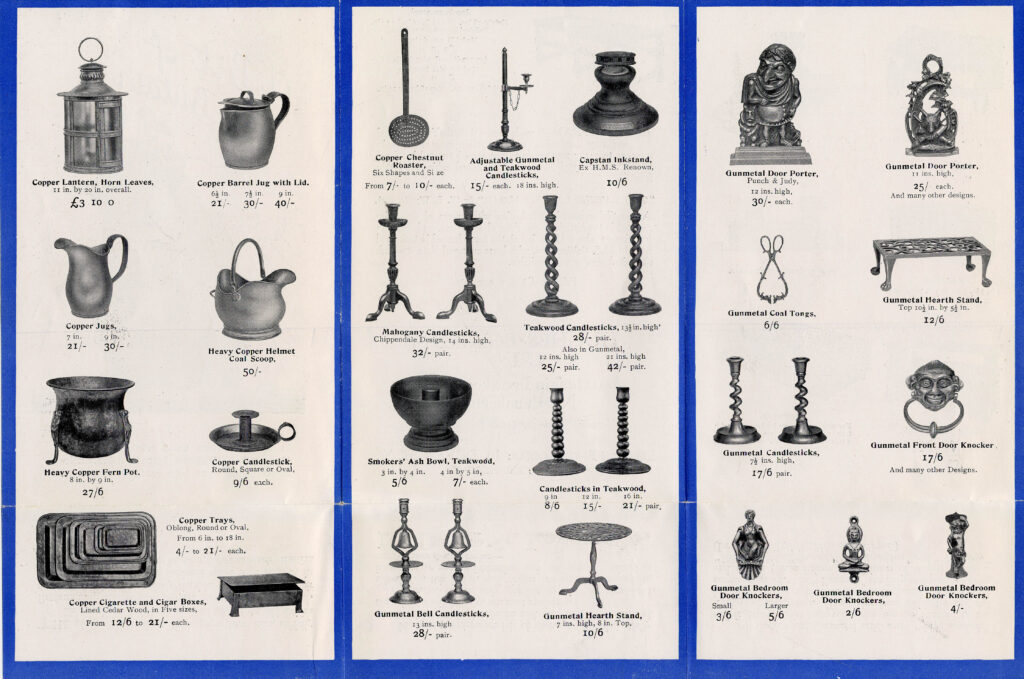Brochure for Hughes Bolckow & Co., Battleship Breakers
Reference: NRO 2674/1, 2
Suggested age groups: KS2, KS3, KS4, lifelong learners
Subject areas: Industrial History, Recycling
CONTEXT
Shipbreaking, sometimes also known as ship recycling, is the process of breaking up old ships that could no longer sail. The ships are either broken up as a source of parts which could be reused on another ship or stripped to extract raw materials which could then be recycled.
During the 18th and 19th centuries, battleships were predominantly made of wood, making shipbreaking a lucrative prospect for furniture makers and timer merchants. By World War I battleships had progressed to being both wooden and steel vessels.
Hughes Bolckow & Co. was founded in 1906. The company rented land from Lord Ridley and the Blyth Harbour Commissioners at Battleship Wharf, Blyth. They bought old ships, particularly battleships, that could no longer sail. They stripped the ships down and made furniture and other household goods from the useable metal and wood. It appears that the company had an extensive business. They sold to the public directly from Blyth and from their showrooms in London. They were one of the most successful shipbreakers in Britain.
The company was famous for breaking a number of notable Royal Navy ships, including HMS Britannia and HMS Southampton. During World War I they also broke up German U-Boats including the captured U-22 which the British Admiralty sold to Hughes Bolckow & Co.
ACTIVITIES
ACTIVITY 1
Background
Shipbreaking, sometimes also known as ship recycling, is the process of breaking up old ships that could no longer sail. The ships are either broken up as a source of parts which could be reused on another ship or stripped to extract raw materials which could then be recycled.
During the 18th and 19th centuries, battleships were predominantly made of wood, making shipbreaking a lucrative prospect for furniture makers and timer merchants. By World War I battleships had progressed to being both wooden and steel vessels.
SEE
See: What is shipbreaking?
See: What happened to the parts of the ship that were taken apart while shipbreaking?
See: What were battleships made of during the 18th and 19th centuries?
See: What was Hughes Bolckow & Co.?
See: What did Hughes Bolckow & Co. do?
See: What items are shown in the Hughes Boolckow & Co. brochure?
THINK
Think: Why was shipbreaking introduced?
Think: What types of items could be made from a recycled ship?
Think: Does shipbreaking still happen today?
Think: What are ships made of today?
Think: What is recycling?
Think: Why is recycling important?
DO
Do: Look up HMS Britannia. Find out how she was involved in the First World War and how she was sunk.
Do: Look up HMS Southampton. Find out how she ended up at Hughes Bolckow & Co.
Do: Look up U-22. Find out the role it played in the First World War and how it was captured by the British.
Do: Choose one of the ships or U-boat that you have researched. Write an article about their journey from battleship to household furnishing made by Hughes Bolckow & Co.
Do: Come up with designs for a warship using materials that could be recycled or repurposed.
Do: Create a model of your warship using materials that could be recycled or repurposed.
Do: Swap warship models with someone else. Come up with a series of designs of how the warship materials could be reused or repurposed to become something else such as furniture.
Do: Dismantle the warship and use its parts to create some of your designs.
Do: Create a brochure advertising your designs.
Resources
https://military-history.fandom.com/wiki/HMS_Britannia_(1904)
https://uboat.net/wwi/boats/?boat=22https://military-history.fandom.com/wiki/SM_U-22_(Germany)
https://www.gracesguide.co.uk/Hughes,_Bolckow_and_Co
https://www.milesgriffithsantiques.co.uk/product/rare-antique-teak-armchair-by-hughes-bolckow/
OTHER ONLINE RESOURCES
Post of Blyth website, page about Battleship Wharf: https://portofblyth.co.uk/facilities/battleship-wharf-terminal/
Graces Guides website, page about Hughes, Bolckow and Co: https://www.gracesguide.co.uk/Hughes,_Bolckow_and_Co
About Blyth website, page about shipbreaking (includes list of ships): https://aboutblyth.co.uk/shipbreaking-at-blyth/



